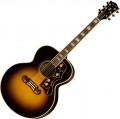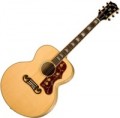Type
General type of tool.
First of all, it is worth noting that the name “acoustic guitar” in our time can be used both in a broad sense (to denote a whole class of instruments) and in a narrow sense (to denote one of the types of such instruments). Acoustic guitars in the broad sense of the word also include
classical and
electro-acoustic models, as well as more specific instruments -
acoustic bass guitars and
ukuleles. Here is a detailed description of each of these varieties.
—
Acoustic. Speaking about the types of guitars, “acoustic” refers to relatively modern models that differ in design from the “classics” (see below). In terms of capabilities, the main features of such instruments are the ability to use metal strings, as well as a generally louder and more sonorous sound. Externally, acoustic guitars (in the narrow sense of the word) are distinguished primarily by a relatively narrow and long neck, as well as a slightly different bridge design than classical ones; in addition, most models also have a larger body, the shape of which can be very diverse (see “Shape (type)”). This type of guitar can be used for different playing styles; in this sense it is more versatile than classic models.
- Classic. Instruments created on the basis of traditional Spanish guitars back in
...the 19th century and surviving to this day almost unchanged. The classical guitar has a fairly wide neck, as well as a characteristic body shape; this shape is actually a standard, so different models are very similar in outline and differ in appearance mainly in color and the presence/absence of a cutout (see “Cutaway”). The main functional feature of such instruments is the inability to work with metal strings - on the “classics” you can only use nylon. Due to this, such guitars sound very soft and relatively quiet, and as a result, they are poorly suited for aggressive, dynamic chord playing. Therefore, the main purpose of such instruments is classical compositions. Also, this type of guitar is well suited for initial music learning: nylon strings do not cut your fingertips as much as metal ones.
— Electroacoustic. Acoustic guitars, complemented by built-in pickups and, as a rule, tone blocks (see below for both). This allows you not only to use the guitar in a traditional, acoustic format, but also to connect it to an amplifier or other equipment, incl. to add additional effects to the sound using “gadgets”.
- Ukulele. An instrument also known as the "ukulele". Outwardly it is really very similar to a guitar, but it is much smaller in size. There are usually 4 strings on such an instrument; there are other options - 8 (4 double) or 6, as on a regular guitar (“guitalele”), such models are also included in this category. The ukulele became widespread in the Pacific Islands and from the very beginning was associated with Hawaiian traditional music, but this does not stop there: almost the same possibilities are available for such instruments as for ordinary acoustic guitars.
- Bass. Guitars with a low, bass sound. The classical bass has 4 strings in EADG tuning - similar to the third through sixth strings of a six-string guitar, but an octave lower; The strings themselves, accordingly, are also much thicker. Five-string models are less common; they have a similar tuning principle (see “Number of strings”). Externally, many basses stand out with long and narrow necks, although this is not strictly necessary. A special case is the fretless bass: such an instrument does not have saddles on the neck, which expands the possibilities for using various specific sound production techniques, but requires special precision when placing the fingers. In any case, the main use of bass is rhythmic accompaniment, most often in combination with drums; For solo parts, such an instrument is practically not used. Also note that acoustic basses are usually supplemented with pickups - similar to the electro-acoustic guitars described above: it is very difficult to sound such an instrument in another way (with an external microphone).Pickup
The presence of
a pickup in the design of the guitar.
The pickup allows you to connect the instrument to external equipment — for example, for a concert; it, in accordance with the name, provides sound transmission from the strings to the output (usually through the tone block, see below). By definition, all
electric acoustic guitars have this feature, and basses are usually equipped with pickups (see “Type”).
Type
The type of tone block installed in a guitar with a pickup (see above).
The tone block is responsible for processing the signal coming from the pickup before applying this signal to the output of the instrument. Such processing includes at least frequency correction, often also amplification; in addition, it is through the tone block that such functions as a tuner for tuning and an equalizer are implemented (see below). And the types of such blocks can be as follows:
— Active. Tone blocks operating from their own power source (usually a replaceable battery). Such modules are more complicated and more expensive than passive ones, besides, when using them, you need to monitor the condition of the batteries and change them in time. On the other hand, the active operation scheme allows you to implement many advanced functions: high-quality frequency correction, gain, impedance matching with an external amplifier, as well as the equalizer and tuner mentioned above. Thus, most guitars with pickups nowadays are equipped with active tone blocks.
— Passive. Passive tone blocks do not have electronics that require additional power, so they are inexpensive and extremely easy to use. At the same time, the capabilities of such blocks are much more modest: for example, timbre correction in them is carried out only by cutting off “extra” frequencies, and there is no talk of amplification at all. This variant has not been widely used.
Bridge
The material from which the bridge (string holder) of the guitar is made is a device with which the strings are attached to the top deck.
Theoretically, the colour of the sound of an instrument depends on the characteristics of all its details. However, in the case of the bridge, this influence is so insignificant that the data on the material in this case are more of general reference and advertising than of real practical value. The variety of such materials is quite large; among the most common are
rosewood,
mongoy and
ebony.
Scale
Scale length of the guitar. The scale in this case is the working part of the string, in other words, the distance from the saddle (on the headstock) to the saddle (on the bridge). In most acoustic and similar guitars, the scale is set during production and is unchanged. Without going into technical details, we can say that the value of this parameter is generally a reference: it allows you to some extent estimate the overall dimensions of the instrument, as well as the size of the frets (the longer the scale, the larger the size of the frets, regardless of their number). However, there is also a practical application: with an adjustable anchor (see above), the scale length data can be useful in the tuning process.
Fretboard
The fingerboard material is the surface directly under the strings. Now the most commonly used materials are:
rosewood,
mongoy and
ebony. For the value of this parameter, see p. "Top deck".
Case
The presence of a
case or cover in the tool delivery kit (what exactly is included in the kit must be specified in each case separately).
A case is called a case made of hard materials, a case is made of soft materials, this is the main difference between these types of accessories. Otherwise, they are similar: both the case and the cover are provided primarily for the convenience of transporting the tool. To do this, the design provides for handles, shoulder straps and other devices that facilitate carrying, as well as compartments for additional accessories (replaceable strings, tuners, etc.). However, it is desirable to store the tool in a case or case — to protect it from dust and other adverse factors.
The “native” case/case is good because it optimally fits a specific guitar model and is immediately sold with it, saving the owner from unnecessary searches. On the other hand, manufacturers often include the simplest types of cases in the kit, with minimal additional features and a very limited degree of protection. This is especially true for cases that can be made of thin material and are only suitable for short-distance movements in warm weather without rain. Therefore, sometimes it makes more sense to buy a case separately.

